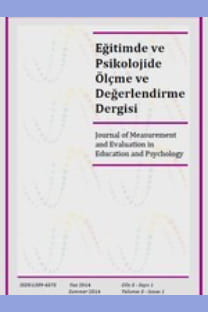jMetrik, Madde Tepki Kuramı, Klasik Test Kuramı, Değişen Madde Fonkisyonu
JMETRIK: Classical Test Theory and Item Response Theory Data Analysis Software
___
- Aksu, G., Reyhanlıoğlu, Ç., Eser M. T. (2017). Examining the two categorical datas by jMetrik, Bilog-MG and IRTPRO with application of mathematics exam. European Scientific Journal, 13(33).
- Crocker, L., & Algina, J. (1986). Introduction to classical &modern test theory. Orlando, FL: Holt, Rinehart & Winston.
- Embretson, S. E., & Reise, S. P. (2000). Item response theory for psychologists. Lawrence Erlbaum Associate, Inc.
- Haebara, T. (1980). Equating logistic ability scales by a weighted least squares method. Japanese Psychological Research, 22(3), 144–149.
- Hambleton, R. K., & Swaminathan, H. (1985). Item response theory principles and applications. Boston-USA: Kluwer-Nijhoff Publishing.
- Kim, S. & Kolen, M. J. (2007). Effects of scale linking on different definitions of criterion functions for the IRT characteristic curve methods. Journal of Educational and Behavioral Statistics, 32(4), 371–397.
- Lord, F.M. & Novick, M.R. (1968) Statistical Theories of Mental Test Scores. Addison-Wesley, Menlo Park.
- Loyd, B. H. & Hoover, H. D. (1980). Vertical equating using the Rasch model. Journal of Educational Measurement, 17(3), 179–193.
- Marco, G. L. (1977). Item characteristic curve solutions to three intractable testing problems. Journal of Educational Measurement, 14(2), 139–160.
- McDonald, R. P. (1999). Test theory: A unified treatment. Mahwah, NJ: Lawrence Erlbaum Associates.
- Meyer, J. P. (2010). Understanding measurement: Reliability. New York: Oxford University Press.
- Meyer, J. P. & Hailey, E. (2012). A study of Rasch partial credit, and rating scale model parameter recovery in WINSTEPS and jMetrik. Journal of Applied Measurement, 13(3), 248–258.
- Meyer, J. P. (2014). Applied Measurement with jMetrik. New York: Routledge.
- Meyer, J. P. (2018). jMetrik. In Van Der Linden, W. (Ed.). Handbook of Item Response Theory, Volume 3. Boca Raton, FL: Taylor & Francis.
- Stocking, M. L. & Lord, F. M. (1983). Developing a common metric in item response theory. Applied Psychological Measurement, 7(2), 201–210.
- Wright, B. D. & Masters, G. N. (1982). Rating scale analysis. Chicago, IL: MESA Press.
- ISSN: 1309-6575
- Yayın Aralığı: 4
- Başlangıç: 2010
- Yayıncı: Selahattin GELBAL
Derya ATALAN ERGİN, Emine Gül KAPÇI
Sakine GÖÇER ŞAHİN, Metin BULUŞ
Abdullah Faruk KILIÇ, Nuri DOĞAN
Metin BULUŞ, Sakine GÖÇER ŞAHİN
İbrahim UYSAL, Levent ERTUNA, F. Güneş ERTAŞ, Hülya KELECİOĞLU
The Effect of Item Weighting on Reliability and Validity
Nuri DOĞAN, Abdullah Faruk KILIÇ
Gökhan AKSU, Cem Oktay GÜZELLER, Mehmet Taha ESER
İbrahim UYSAL, Levent ERTUNA, Hülya KELECİOĞLU, F. Güneş ERTAŞ
